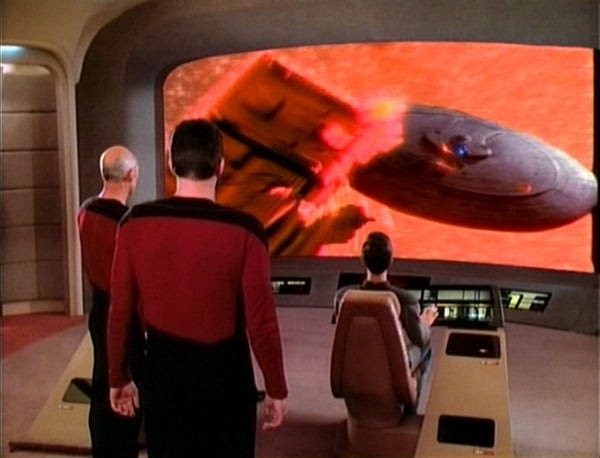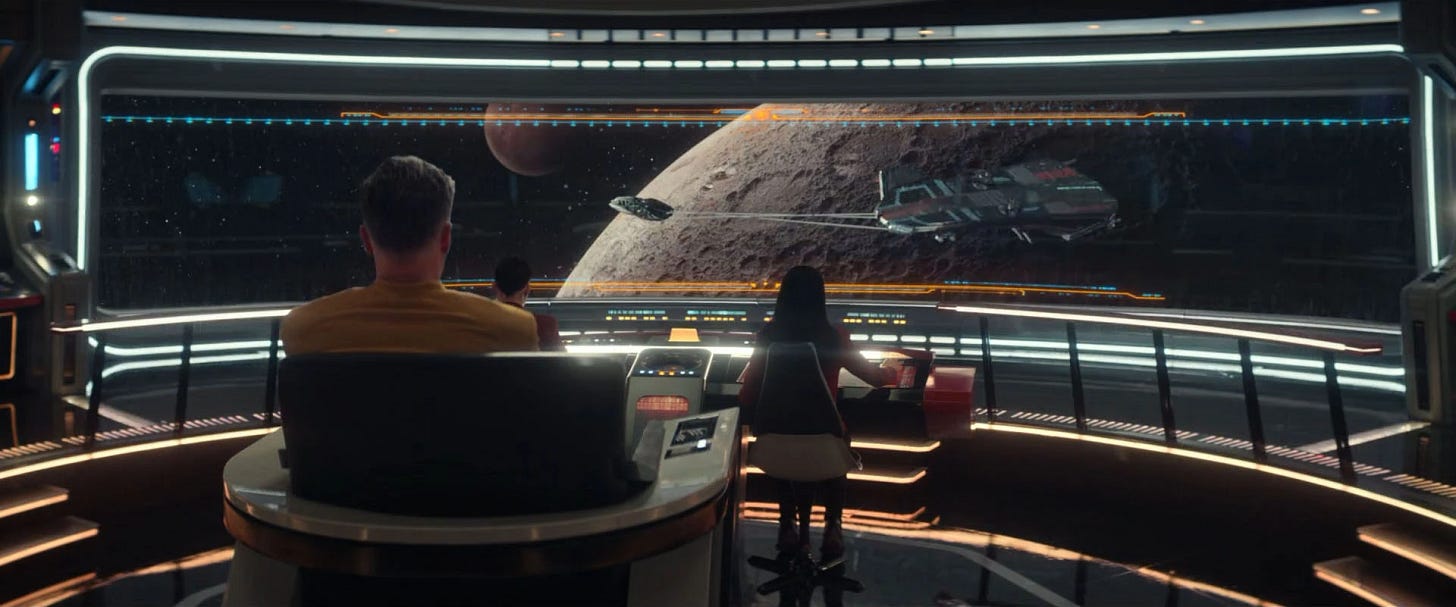Life is a Room with a TV
Star Trek as paracosmal living room
I’ve been watching Star Trek: The Next Generation with my girlfriend. It’s surprising that both of us have enjoyed the show so much because, in the same timeline that we started watching it, we’ve also had many arguments about AI — something that she feels ambivalent toward and I write a lot about. Yet we enjoy this show centered around techno-sophistry. I chalk this up to TNG plots being somewhere between magic and technology, the former being a subject my girlfriend investigated in her own way through a project called Texas Overture. The easy explanation for why TNG feels this way would be that it came from a more optimistic era of technology, but I’m not sure that’s true. The show premiered only a few years before the fall of the Berlin Wall, at a time when the Unabomber, DeLillo’s White Noise, and other techno-paranoid voices were already part of the cultural conversation. The techno-optimism case, I suspect, is overstated.
The second explanation, and one that I favor, is that TNG does not care too much to explain why something might be plausible in its world. It is set in a world with child-like rules and logic, something
calls a paracosm. Paraphrasing Simon, legibility is second to playfulness in world of TNG. The lack of legibility and the heightened playfulness make TNG feel like magic, but the world itself is bounded by special rules, not special people, which makes it feel like sci-fi.***
I’ve been watching the latest iteration of Star Trek, Strange New Worlds, in parallel, and one thing that struck me is the evolving role of the viewscreen in the Star Trek universe. The viewscreen, for the uninitiated, is a display on the bridge of Starfleet ships that works with some kind of advanced holographic technology. The viewscreen is the shared context for everyone on the bridge of a Starfleet vessel; it is where the action unfolds or begins in probably 90% of TNG episodes. It is also peak television because, as a viewer, you are essentially watching other people watching things on a screen. This has a curious “medium is the message” effect on how you see TNG episodes. The more I watch, the more I feel like every episode that introduces a new world mimics the experience of changing channels in cable television. The forgotten magical experience of going from Adventures of Batman to Animal Planet to Buffy the Vampire Slayer. I’ve seen the bridge on the original series being compared to navy ships, but in TNG, the bridge feels like a living room with Danish-looking chairs, and the crew gathers around the viewscreen to watch the shared action unfold.
The TV analogy makes even more sense when you consider that the crew of the Enterprise are not seeing raw images on the viewscreen. It functions less like a window and more like a real-time composite—an advanced version of the Hubble Space Telescope. Hubble doesn’t capture color photographs of the cosmos. It collects light from distant objects through a series of filters, each isolating a different wavelength—visible, infrared, ultraviolet. The telescope’s sensors translate those photons into streams of data, which scientists later combine and colorize to create the vivid images we recognize. The image is interpretative. The viewscreen on TNG likely works in a similar way, rendering a live synthesis of sensor data—warp signatures, subspace readings, depth and motion—into something visually coherent for human perception. Both instruments turn incomprehensible data into something legible, transforming the unseen into a shared image of the universe.
The evolution of the viewscreen in Star Trek through the decades follows our changing relationship with screens over the decades. In the newer iteration, the viewscreen envelopes the entire bridge of the ship, which eerily reminds me of the Las Vegas sphere. But even though it has much more real estate, the viewscreen is much less central to the plots of Strange New Worlds. In earlier iterations of Star Trek, the viewscreen was something through which you observed and engaged the world at a cool distance, in the new episodes, the viewscreen is just one of many screens through which members of Starfleet access the world. In addition, now there are a plethora of AR screens and continuous data feeds surrounding the crew at all times — mirroring TVs status as just one screen among many in our lives.
If the plots in TNG were about discovering new worlds and new types of energy beings, in the newer one, the well-executed plots revolve around parallel timelines and time travel—something which has become a metamodern trope of sorts. Parallel timelines, which evoke the image of multiple streams, makes sense for a world that is dominated by different streams of information, each competing to become an ontology on its own—prediction, revanchism, new romanticism, etc.—all of us moving between them seamlessly most of the time until we are in conflict with another stream of information. TNG was set in a television ontology, while Strange New Worlds is set in a streaming ontology.
Now I wonder what the next iteration of the viewscreen would look like. If you think of LLMs as the emergent media of their time, then what would stories that invoke the temporality of LLMs look like? If LLMs are a snapshot of culture at a particular moment in time, then what would that look like for Starfleet? Of course, LLMs themselves are a very narrow lens to built an ontology around, so whatever we imagine might look like the early iterations of viewscreen in The Orginal Series, when TV was a relatively newer medium.
P.S: something I forgot to add before publishing. In a way, Star Trek quietly ended the genre of single-room dramas like 12 Angry Men by inventing a new kind of single-room drama — one in which there was a screen in the room, and through that screen, you could go anywhere. The bridge became both stage and portal, collapsing the distance between interior and exterior, control room and cosmos.



I said "woah" out loud when I read this. I've watched most episodes of TNG a couple of times (not the bad ones thanks to Let's Watch Star Trek), but this had never occurred to me.
Regarding techno-optimism: Every iteration of Star Trek has been more optimistic than the era it was produced in. If Star Trek contains a lot of magic, it's because SF and Fantasy struggle generally to keep themselves apart -- sufficiently advanced technology and midichlorians and all that.
Regarding LLMs: I have been thinking lately about how much of Star Trek's attitude toward AI is implicit in how the ship's computer behaves. I have to imagine they considered exactly what kinds of requests it responded to and how. It tends to be sort of terse and clearly mechanistic. They call it "Computer" and it responds with dry information, even when it has done some pretty complex analysis. Yet, if you subscribe to the "Moriarty is the Computer" theory, it's obviously teetering on the edge of emergence. (All of this is far more interesting than whether Data is conscious because obviously, yeah, he probably is insofar as we can ever judge such things, but he's emerging from a simulationist paradigm that recreates humanoid perception and cognition, whereas the Computer is more like an LLM.)